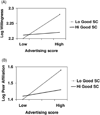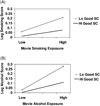Good self-control moderates the effect of mass media on adolescent tobacco and alcohol use: tests with studies of children and adolescents
- PMID: 20836609
- PMCID: PMC3719172
- DOI: 10.1037/a0020818
Good self-control moderates the effect of mass media on adolescent tobacco and alcohol use: tests with studies of children and adolescents
Abstract
Objective: To investigate whether self-control moderates the effect of media influences on tobacco and alcohol use among youth and if so how this effect occurs.
Design: In Study 1, a regional sample of 10-year olds (N = 290) was interviewed in households; attention to tobacco/alcohol advertising was assessed. In Study 2, a national sample of youth ages 10-14 years (N = 6,522) was surveyed by telephone; exposure to tobacco/alcohol use in movies was assessed. Good self-control was measured in both studies.
Main outcome measures: Willingness to use substances and affiliation with peer substance users (Study 1); involvement in smoking or drinking (Study 2).
Results: In Study 1, the effect of tobacco/alcohol advertising on predisposition for substance use was lower among persons scoring higher on good self-control. In Study 2, the effect of movie smoking/alcohol exposure on adolescent tobacco/alcohol use was lower, concurrently and prospectively, among persons scoring higher on good self-control. Moderation occurred primarily through reducing the effect of movie exposure on positive smoking/alcohol expectancies and the effect of expectancies on adolescent use; some evidence for moderation of social processes was also noted. Covariates in the analyses included demographics, sensation seeking, and IQ.
Conclusion: Good self-control reduces the effect of adverse media influences on adolescent tobacco and alcohol use. Findings on the processes underlying this effect may be useful for media literacy and primary prevention programs.
(PsycINFO Database Record (c) 2010 APA, all rights reserved).
Figures




References
-
- Audrain-McGovern J, Rodriguez D, Tercyak KP, Nenner G, Moss HB. The impact of self-control indices on peer smoking and adolescent smoking progression. Journal of Pediatric Psychology. 2006;21:139–151. - PubMed
-
- Austin EW, Chen MJ, Grube JW. How does alcohol advertising influence underage drinking? The role of desirability, identification and skepticism. Journal of Adolescent Health. 2006;38:376–384. - PubMed
-
- Austin EW, Chen Y-C, Pinkleton BE, Johnson JQ. Benefits and costs of media-literacy training in a middle school setting. Pediatrics. 2006;117:423–433. - PubMed
-
- Austin EW, Knaus C. Predicting the potential for risky behavior among those “too young” to drink as the result of advertising. Journal of Health Communication. 2000;5:13–27. - PubMed
-
- Barkley RA. Behavioral inhibition, sustained attention, and executive functions: Constructing a unifying theory of ADHD. Psychological Bulletin. 1997;121:65–94. - PubMed

